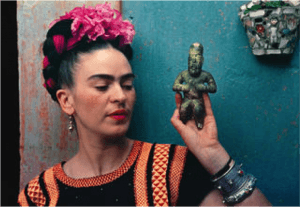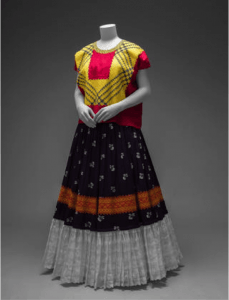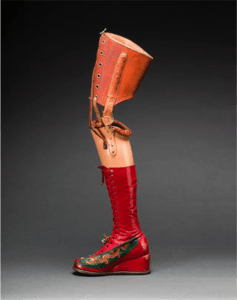
BA (Hons) History of Art and Design graduate (2018) Wendy Fraser reviews the V&A’s current Frida Kahlo show

Figure 1 Frida Kahlo with Olmec figurine, 1939. Photograph Nickolas Muray. © Nickolas Muray Photo Archives. Photographed by her lover, Kahlo wears a traditional Tehuantepec-style cotton huipil with her hair in her signature style plaited with fabric and adorned with real flowers.
Frida Kahlo’s image has become ubiquitous in popular culture; famous for her monobrow and flowers in her hair, Kahlo is the subject of many other artists’ work and her face adorns stationery, cushions, jewellery and there is even a Frida Barbie. It is fitting that while Kahlo can be regarded as more famous for her look than for her body of artwork that the V&A’s new exhibition Frida Kahlo: Making Her Self Up focuses on her carefully constructed appearance. (Figure 1)
The exhibition has been created around artefacts discovered in 2003 in Kahlo’s childhood home, the Casa Azul (now the Museo Frida Kahlo) in the Coyoacán area of Mexico City. Over 6000 photographs, 22,000 documents and 300 other items including clothing, jewellery, accessories, medicines, make up, and orthopaedic devices were found in the hoard.[i]These personal items had been sealed up in a bathroom, fifty years earlier, by Kahlo’s husband the artist Diego Riviera (1886-1957) who was part of the Mexican muralist movement. While the articles have been displayed in Mexico, it is the first time they have been shown outside the country.

Figure 2 Cotton huipil with machine-embroidered chain stitch; printed cotton skirt with embroidery and holán (ruffle). Photograph: Museo Frida Kahlo.
Frida Kahlo (1907-1954) was born Magdalena Carmen Frida Kahlo y Calderon to a German father, a photographer and a Mexican/Spanish mother. Kahlo’s painting career began when she was recovering from terrible injuries she suffered in 1925 when a bus she was travelling on collided with a tram and she was impaled on a handrail. She became her own favourite subject – of the 143 paintings she left, 55 are self-portraits.[ii]Kahlo’s interest in indigenous Mexican culture is expressed in the symbolism of her artwork and she began to wear traditional dress, particularly the clothing of the women of the Isthmus of Tehuantepec. ‘The matriarchal society of the Tehuanas held a particular appeal for Kahlo, who was building her own image as an outsider: independent, but faithful to tradition, while at the same time embracing a modern, liberated lifestyle’.[iii]The clothing served a practical purpose too; long skirts hid her leg that had been wasted by childhood polio and the loose huipil blouses (square-cut tunics with no darts or shaping in patterned or embroidered cotton) accommodated the plaster casts and leather corsets that she was forced to wear following her accident and both were worn with a rebozos, a rectangular fringed shawl. (Figure 2) Kahlo ensured that all eyes were averted from her injured limb to her upper body with decorative blouses, flamboyant jewellery and her elaborate hairstyle of braids interlaced with yarn or ribbons and decorated with real flowers.
The first room of the exhibition shows photographs of the family of six daughters, mostly taken by Kahlo’s father; in one formal portrait Kahlo has slicked her hair back and wears a man’s three-piece suit, in others she wears European-style clothes. The first pieces of clothing encountered are displayed on two mannequins, one wearing a French black velvet cape and brocade skirt and the other in a Tehuana outfit with a full red skirt and blouse which sit together holding hands echoing Kahlo’s 1939 oil painting The Two Fridas and emphasising her dual heritage. Photographs of Zapotec women at market wearing indigenous dress by the Italian photographer Tina Modotti demonstrate that in Mexico Kahlo’s costumes were the custom while photographs of Kahlo against the New York skyline by her lover Nickolas Murray highlight what a curiosity she must have seemed on her frequent visits to the US.

Figure 3 Frida Kahlo’s prosthetic leg with red leather lace up boot with embroidered appliqued panel with Chinese motifs. Photograph Javier Hinojosa. Museo Frida Kahlo. ©Diego Riviera and Frida Kahlo Archives.
Innovative display techniques have been used throughout the exhibition: the heads of the many mannequins have Kahlo’s face and hairstyle with moulded braids and flowers. Display cabinets have been made to represent Kahlo’s four poster bed in which she was often confined while recuperating from her many surgeries using a mirror rigged up over the bed to continue to paint herself. A mannequin bust has been wrapped in plaster-dipped bandages to mimic Kahlo’s body casts and used to display some of Kahlo’s vast jewellery collection. The most poignant exhibit is a pair of black suede heeled tie-up shoes. The toe area on the right shoe has been cut out to accommodate and prevent pressure on Kahlo’s gangrenous toes. Next to them is her prosthetic leg with a red leather wedge boot which laces up to mid-calf with a Chinese dragon embroidered on a silk panel decoration on the foot (Figure 3) which she wore in 1953 after the amputation of her leg.
The most personal items on display are Kahlo’s cosmetics, empty perfume bottles, medication (including Demerol, an additive opioid) and her orthopaedic corsets. Her perfumes included Chanel No5 and Shalimar and she favoured lipsticks in red and a dark pink called Everything’s Rosy by Revlon.
Frida Kahlo: Making Her Self Up reveals how Kahlo’s constructed appearance was as much a part of her artwork as her paintings. Her adoption of indigenous dress was a powerful political statement about her Mexican identity that aligned her with a matriarchal society and additionally helped to disguise her disabilities. Kahlo’s suffering was unimaginable and the real strength of the exhibition is that by juxtaposing her clothing and personal effects with her self-portraits and photographic portraits, Kahlo emerges as a three-dimensional woman and transcends her commodified image of popular culture.
Frida Kahlo: Making Her Self Up is at the V&A from 16 June – 4 November 2018
[i]Hilda Trujillo Soto, “Treasure in the Blue House”, Frida Kahlo: Making Herself Up, eds., Claire Wilcox and Circe Henestrosa (London, V&A Publishing, 2018) 21.
[ii]“Biography of Frida Kahlo,” Frida Kahlo Foundation website. [n.d.]
[iii]Circe Henestrosa, “Appearances can be Deceiving- Frida Kahlo’s Construction of Identity: Disability, Ethnicity and Dress,” Frida Kahlo: Making Herself Up, eds., Claire Wilcox and Circe Henestrosa (London, V&A Publishing, 2018) 70.